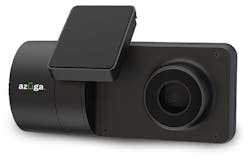Fleets explore all that telematics data can do
Telematics solutions contain a lot of data points for fleets—so much so that mining through the data and picking out what’s important can be quite a challenge.
Omaha, Nebraska-based Hill Brothers Transportation operates some 250 power units and recently has only just begun to scratch the surface of utilizing telematics data to the fullest, according to Raul Soria, the carrier’s director of safety.
During a Transflo webinar on five “new and genius ways” for using telematics data, Soria said Hill Brothers uses driver scorecards and telematics data to help govern speed and identify high-risk driving behaviors across the company. Hill Brothers also leverages its telematics data to identify vehicles that have not been spec’d to include speed governing devices.
According to Soria, the carrier generates a report that tells management who is driving faster than the company threshold of 70 mph.
“It tells me anyone that exceeds 73 mph for more than five minutes,” Soria pointed out. “That will account for any changes in terrain—whether we are going uphill or downhill—so we can identify the vehicles that are not governed according to the 70-mph speed setting. It’s been helpful to identify those vehicles more closely with maintenance and operations when they are heading back to our terminal so we can correct the speed setting on that vehicle.”
Fleet telematics is evolving rapidly from tracking locations to leveraging the data to make better business decisions, explained Azuga CEO Ananth Rani. The data, he added, is increasingly complex and involves data analytics of the vehicle health, the driver behavior, and predictive risk models.
“Geospatial data isn't going away, but the power of telematics has become a must-have solution for any business that runs on wheels,” Rani told FleetOwner. “Optimizing efficiencies within the fleets is one of the biggest challenges we hear our customers talk about today. They are experiencing increased workloads with high expectations, and they are looking to their fleet telematics provider to help optimize their routes and ensure driver productivity.
“A common example of this is companies have the same amount of drivers but 25% more jobs within the same workweek, so they are looking for ways to accomplish 25% more and fleet telematics offers the insights they need to take action on these operational efficiencies,” Rani added.
The report provides information on each major MRM market segment, including the markets for vehicle-installed GPS fleet management and video/driver behavior monitoring solutions. It also covers the market for supply chain visibility platforms, commercial insurance telematics, and field service management solutions.
“Continuing market growth will be fueled by factors such as declining hardware costs and lower service fees for basic solutions, according to C.J. Driscoll & Associates. “Video-based solutions and other optional features will help to support revenues, including those offered through solution provider marketplaces. Significant merger and acquisition activity has been occurring, which shows the ongoing confidence of both strategic and financial investors in the near- and long-term prospects for the industry. Also, emerging technologies such as artificial intelligence, machine learning, and edge computing are opening the doors to increasing innovation in solutions for safety and productivity in the management of vehicles, assets, and human resources.”
Azuga’s Rani added that the current trends around data reliance will continue and only get more complex (especially with the introduction of autonomous vehicles). Therefore, he said he expects the reliance on AI and machine learning will continue to grow.
“The business decisions will also expand further into tire analytics, insurance claims, and more,” Rani said. “Essentially, telematics will enable predictive models that prevent accidents, automate the maintenance schedules of vehicles, improve routing optimization further, and so much more.”
Visibility via geofencing
For Travis Hamdan, general manager of Condesa Freight International, when the electronic logging device (ELD) mandate went into effect, the fleet created a driver and telematics portal that drivers could access from their phones. That was important because Condesa has operations in the U.S. and Mexico and needed its solutions to work in unison for drivers.
The fleet, which utilizes the Transflo system, uses breadcrumbs to track its units, providing coordinates to the carrier’s customers along the way. Condesa has a sister fleet in Mexico with 100 trucks, and this system gives fleet management “great visibility,” Hamdan said during the Transflo webinar.
Condesa Freight has also placed a geofence around shipper facilities and has utilized the virtual perimeter to track truck activity, facility hours and contact information, and to schedule an automatic remittance when a truck unit, equipped with an ELD or telematics solution, enters the location.
When a unit gets to a certain location, Tranflo’s Larsen explained that a geofence also can be set up to trigger an alert for maintenance operations.
From a cross-border standpoint, Condesa has used geofences to provide continuous capacity notifications to customers. The carrier’s IT team in Mexico has been able to unify the systems and provide information within the geofence that relays or auto communicates information to the shipper, broker, or customer who is asking for the service.
“It’s great to have direct communications with shippers and sometimes it’s easier for them to have that way of immediately going in and knowing that Condesa has two or three trailers of capacity,” Hamdan said. “We want to make sure there is continuous visibility on the equipment and not just a text message asking if equipment or truck is in this particular area. We always want to make sure that they can see and anticipate when they will have capacity within a particular area.”
The carrier has also relied on geofencing to alert drivers of routes in which they should be more cautious. On certain routes south of the border, Hamdan said Condesa has used geofences to block off certain lanes that might be notoriously known for cargo theft or other potentially unsafe encounters.
“Safety is also super important, especially with more and more women joining our industry,” Verlen Larsen, solutions architect at Transflo, stressed. “One of their top concerns is always where are they going to be safe or not. Whether it’s north or south of the border, that’s a big deal.”
Monitoring driving behavior, idle times
When it comes to managing drivers, recognizing the top and bottom performers is important, Larsen noted. Drivers, he said, like to have something that they can work toward as well as setting an example for other drivers to follow.
At Hill Brothers Transportation, onboard telematics devices can detect G-forces, triggering hard braking or acceleration alerts for drivers, Soria pointed out. The fleet takes that information and puts it in a scorecard to help address how drivers are performing.
“Once you are having a meeting and discussion, you can go into a specific date and occurrence and look at the data and use that breadcrumb information to determine, for instance, seatbelt usage,” Soria said. “I can tell precisely when the driver applied his seatbelt and when he took it off, so we are able to have a more in-depth conversation about seatbelt compliance.”
Transflo’s Larsen noted that telematics devices can also be used to help fleet managers track ambient temperature around a truck. He said some fleets have been using that as a tool to better manage idle time.
“They are really focusing on those things that make a difference because you don’t want a driver trying to sleep when it’s too hot or cold in the cab because that’s just inhumane,” Larsen pointed out.
According to C.J. Driscoll’s report, the fastest-growing sector in commercial telematics is video telematics. Video is penetrating all fleet segments due to the desire of fleet operators to determine liability in the event of an accident and for driver coaching, the firm noted.
The report also points out that insurance telematics is becoming more important for fleet insurers. Some commercial insurers are mandating that fleets adopt telematics while other insurers are offering fleets discounts for adopting this technology.
About the Author

Cristina Commendatore
Cristina Commendatore is a past FleetOwner editor-in-chief. She wrote for the publication from 2015 to 2023.


